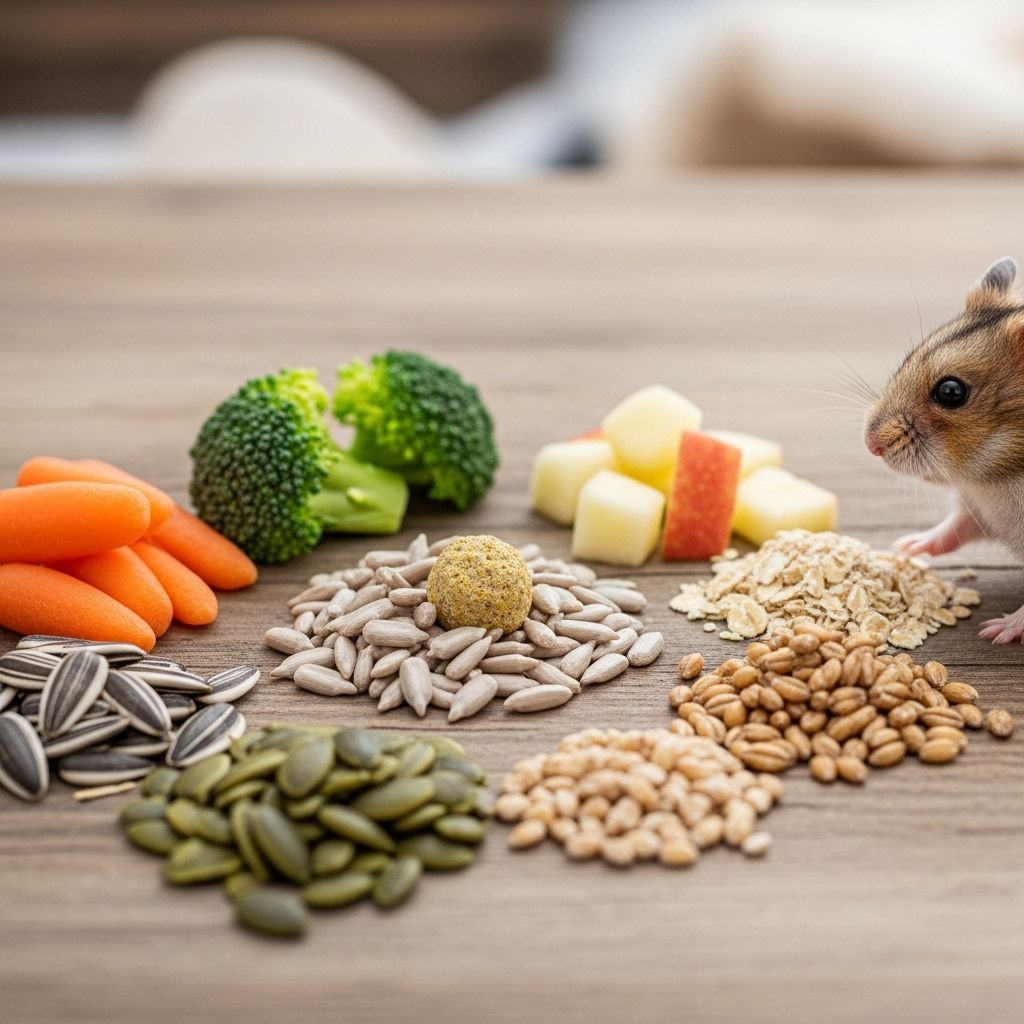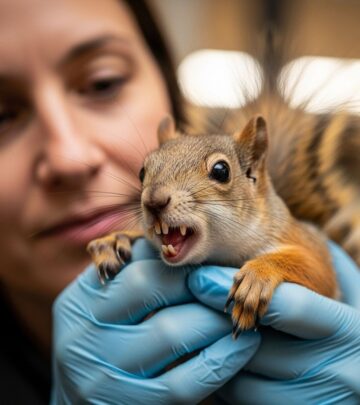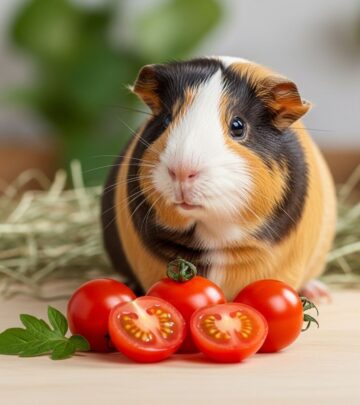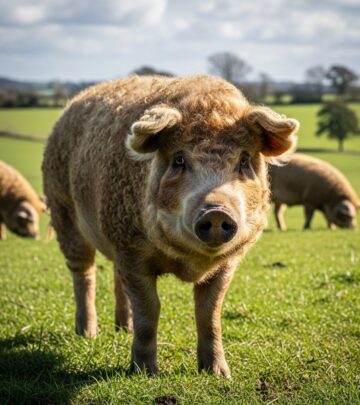What Do Hamsters Eat? The Ultimate Guide to Hamster Nutrition and Safe Foods
Balancing staples and treats keeps your little friend energetic and healthy.

Image: HearthJunction Design Team
Understanding your hamster’s dietary needs is crucial for keeping your tiny companion healthy and happy. Hamsters may be small, but they require a carefully balanced, species-appropriate blend of nutrients for optimal wellbeing. This guide will cover what hamsters can—and can’t—eat, how to build a balanced diet, and advice for safe feeding and treats.
Overview: Hamster Diet Basics
Wild hamsters roam grassy fields, digging up roots, nibbling on seeds, munching on fruits and vegetables, and occasionally snacking on protein-packed insects. Domesticated hamsters need a similarly varied diet that includes precise amounts of carbohydrates, proteins, fats, vitamins, minerals, and plenty of safe, fresh water every day .
- Omnivores: Hamsters eat both plant and animal matter .
- Pellets: Balanced hamster pellets form the foundation of a good diet.
- Fresh produce: Supplement with measured amounts of safe vegetables and fruit.
- Protein sources: Occasional insects, eggs, or cooked chicken provide extra protein.
- Always fresh water: Provide clean, filtered water at all times .
The Ideal Hamster Diet
The core of a healthy hamster diet should be a quality, commercial pellet feed. Unlike seed mixes, which can lead to picky eating and imbalanced nutrition, pellets are designed to offer all necessary nutrients in every bite .
- Hamster Pellets: Choose a reputable brand formulated for your hamster’s species. Check the package for portion size recommendations.
- Seed Mixes: Can be offered in moderation, but ensure your hamster is eating the whole mix, not just fatty or sugary seeds.
- Supplemental Treats & Fresh Foods:
- Leafy greens, carrots, cucumber, squash
- Occasional fruit: apple (no seeds), banana, blueberry, small bits of strawberry
- Protein: boiled egg, mealworm, cricket, cooked chicken
- Whole grains: cooked brown rice, whole wheat pasta, lentils, beans
Always introduce new foods gradually and monitor for digestive upset. Remove uneaten fresh foods after a few hours to prevent spoilage.
Hamster Nutritional Requirements (Approximate)
| Nutrient | Recommended range | Food Sources |
|---|---|---|
| Protein | 15-20% | Pellets, boiled egg, chicken, insects |
| Fat | 4-20% | Seeds (unsalted), nuts (in moderation), pellets |
| Carbohydrates | 35-40% | Pellets, whole grains, vegetables |
| Fiber | High / essential | Hay, vegetables, whole grains |
| Water | Always available | Filtered, fresh daily |
Safe Foods for Hamsters
Hamsters love variety! Fresh snacks are delicious and nutritious when fed in moderation. Here are examples of safe foods to supplement your hamster’s main diet:
- Vegetables (small portions daily):
- Kale, romaine lettuce, dandelion greens, and spinach
- Carrot (high sugar, occasional treat only)
- Cucumber, bell pepper
- Cabbage
- Squash, zucchini
- Peas
Understanding your hamster's preferences can enhance their quality of life. Check out these 5 essential things every hamster wishes their human knew to create a more enriching experience for your furry friend. These insights can help strengthen your bond and ensure their happiness. - Fruits (occasional tiny cubes):
- Apple (seedless), banana, blueberry
- Strawberry – can stain fur
- Melon, pear
- Protein sources:
- Boiled or scrambled egg
- Small pieces of cooked chicken
- Plain mealworms or crickets
- Whole grains & pulses:
- Brown rice (cooked, cooled)
- Whole wheat pasta (cooked, plain)
- Oats, lentils, beans (thoroughly cooked)
- Plain, unsweetened, air-popped popcorn (no butter, salt, or oil)
If you're curious about how to care for other small pets, you won't want to miss our complete guide to a healthy ferret diet. This guide details what ferrets can safely eat to thrive, offering insights for pet owners who have a mix of small animals. - Seeds & nuts (unsalted, plain):
- Sunflower seeds, pumpkin seeds in small amounts
- Peanuts, walnuts (no almonds, as they are toxic!)
Tip: Always wash produce thoroughly, and chop to an appropriate size to prevent choking—especially with baby carrots or harder vegetables.
Foods to Avoid: Dangerous and Toxic Foods
Some foods are downright dangerous for hamsters. Never feed the following items:
- Almonds
- Apple seeds or grape seeds
- Chocolate or candy
- Sugary or salty food (chips, crackers, sweets)
- Citrus fruits (lemon, orange, grapefruit, lime)
- Raw beans or raw potato
- Onions, garlic, leeks, scallions, chives
- Rhubarb (including leaves), tomato leaves
- Pork products, pickles, jams or jellies
- Eggplant, fool’s parsley
Some foods can cause digestive upset, illness, or are even poisonous in small amounts. If your hamster ingests a toxic food, contact your vet immediately.
Hydration: Safe Water and Bottle Hygiene
Hamsters should have constant access to clean, filtered water. Tap water that is high in chlorine is not ideal. Empty and refill your hamster’s water bottle daily, and clean the bottle at least once a week to prevent buildup of bacteria .
Portion Control and Treat Feeding Guidelines
Hamsters’ tiny bodies can’t handle large portions. When feeding fruits or vegetables, offer only a small cube or slice (think: the size of your hamster’s paw) per day. Too much fresh food can lead to digestive problems like diarrhea .
- Treats should equal no more than 5–10% of daily caloric intake.
- Always factor treats into your pet’s overall food allowance to prevent obesity.
- Remove any uneaten fresh food within a few hours.
Tips for Creating a Balanced Diet
- Use a high-quality pellet as the staple, offered daily.
- Supplement with a mix of leafy greens and the occasional vegetable.
- Add tiny fruit bits two to three times a week, not daily.
- Offer an insect or other protein source 1–2 times weekly.
- Use hay for added fiber and for chewing enrichment.
- Watch for stored (“hoarded”) food in your hamster’s cage and remove spoiled items promptly.
Enrichment tip: Scatter food or use puzzle feeders to encourage natural foraging behaviors.
Different Species, Slightly Different Needs
There are several popular pet hamster species, including Syrian (golden), dwarf Campbell, Russian, Roborovski, and Chinese hamsters. Most basic dietary rules apply to all, but portion sizes and fat/protein requirements may vary slightly based on species, age, or health. Always research your hamster’s specific needs and consult with a veterinarian for personalized advice .
Frequently Asked Questions (FAQs)
Q: Can hamsters eat cheese?
A: Hamsters can nibble on a tiny bit of plain, unsalted cheese as an occasional treat, but dairy is not a required or staple part of their diet.
Q: Can I feed my hamster nuts?
A: Yes, hamsters can eat unsalted, plain nuts in small quantities—except almonds, which are toxic. Avoid flavored, salted, or sweetened varieties.
Q: Can hamsters eat bread?
A: Whole grain bread or toast can be given in small amounts, but avoid white bread and never add butter, spreads, or sweeteners.
Q: How do I tell if a new food disagrees with my hamster?
A: Signs of digestive upset include lethargy, diarrhea, or lack of appetite. If you notice any of these, stop the new food and contact your veterinarian if severe symptoms persist.
Q: How can I encourage my hamster to eat more vegetables?
A: Offer a variety, chop or grate for easier eating, and mix small pieces with their regular food. Be patient; it may take a few tries for hamsters to accept new foods.
Final Thoughts: Healthy Hamster, Happy Hamster
Providing a healthy, varied, species-appropriate diet is one of the best ways to keep your hamster active and content for years to come. When in doubt, stick to high-quality pelleted food, supplement with safe, fresh plant foods, limit treats, and always avoid foods on the danger list. Regularly review the latest safe foods list, and consult your veterinarian with any concerns or questions about your pet’s individualized dietary needs.
References
- https://www.thehamingway.com/foodmix/guide/nutritional-requirements
- https://www.petmd.com/exotic/what-can-hamsters-eat
- https://ebhs.org/wp-content/uploads/2021/07/Hamster-Diet-final.pdf
- https://www.pethealthclub.com/uk/pet-advice/hamster-diet-guide
- https://www.ukpetfood.org/pet-care-advice/advice-for-small-mammals/hamster-care-nutrition.html
Read full bio of Srija Burman












